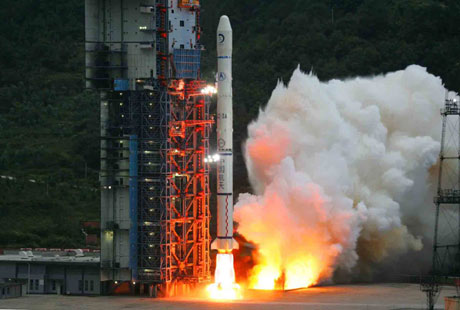China looks for breakthroughs in deep space exploration
(Xinhua)
Updated: 2007-10-31 16:12
Updated: 2007-10-31 16:12
BEIJING - China's space program needs to build up technical expertise and make further breakthroughs in rocket technology before the country can launch a recoverable moon rover, say scientists.
 China's first lunar orbiter, Chang'e I, blasts off from its launch pad in the Xichang Satellite Launch Center in Southwest China's Sichuan Province, at about 6:05 pm October 24, 2007. [Xinhua]
|
Sun Jiadong, chief designer of China's lunar probe project, told Xinhua that as far as technical standards were concerned, China's space exploration equipment was much heavier than that made by developed nations, though the Chinese products were of the same quality, met the same criteria and performed the same tasks.
The lunar probe project had been developed on the basis of former scientific research results, including piloted space flights, Sun said.
China's first lunar orbiter Chang'e-1 - named after a mythical Chinese goddess who, according to legend, flew to the moon - blasted off on a Long March 3A carrier rocket on October 24 from the Xichang Satellite Launch Center, in the southwestern province of Sichuan.
The 2,300-kg satellite, representing the first stage of the three-phase lunar probe project, would enter the earth-moon transfer orbit on Wednesday, a crucial step forward in its 1,580,000-km journey towards the moon.
It will relay the first picture of the moon in late November and will then continue scientific exploration of the moon for a year.
Ye Peijian, the chief designer of Chang'e-1, said technical research had begun for the second phase of the moon exploration project.
"A soft landing vehicle needs a variable thrust engine, whereas the current engines all have fixed thrust," Ye said.
Sun said a dozen or so institutions were involved in the development of lunar rovers needed for the second and third phases of the project.
In line with the current design, one kilogram of lunar soil and rocks at most could be collected in the third stage, Ye said.
In the three-phase mission, a soft moon landing and launch of a moon rover will be completed around 2012, and another rover will land on the moon and return to the earth with lunar soil and stone samples for scientific research around 2017.
The moon rovers and the soft landing vehicle should meet high standards, as they were expected to stay on the moon for three to 12 months, Ye said.
|
|
|
||
|
||
|
|
|
|

